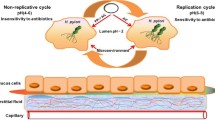Abstract
The antibacterial activity of materials derived from the rhizome of Alpinia officinarum (Zingiberaceae) against Helicobacter pylori ATCC 43504, ATCC 700392, and ATCC 700824 was examined using paper-disc diffusion and agar dilution methods. Results were compared with those following treatment with currently used antibiotics: amoxicillin, metronidazole, and tetracycline. The bioactive principle was characterized as the diarylheptanoid 5-hydroxy-7-(4-hydroxy-3-methoxyphenyl)-l-phenyl-3-heptanone by spectroscopic analysis. This compound was isolated from A. officinarum leaves as a new anti-H. pylori principle. Against H. pylori ATCC 43504, ATCC 700392, and ATCC 700824, the antibacterial activity of the diarylheptanoid (48, 24, and 24 μg/mL) was comparable to that of metronidazole (32, 16, and 16 μg/mL) but less effective than that of either amoxicillin (0.06, 0.06, and 0.03 μg/mL) or tetracycline (0.5, 1, and 0.5 μg/mL), based on minimum inhibitory concentrations. A. officinarum rhizome-derived materials, particularly the diarylheptanoid isolated, merit further study as potential antibacterial functional food products or therapeutic products for prevention or eradication from humans from diseases caused by H. pylori.
Similar content being viewed by others
Abbreviations
- ATCC:
-
American Type Culture Collection
- FT-IR:
-
Fourier transform infrared spectroscopy
- HPLC:
-
high-performance liquid Chromatograph
- MIC:
-
minimum inhibitory concentration;
- MS:
-
mass spectrometry
- NMR:
-
nuclear magnetic resonance spectrometry
- TLC:
-
thin-layer chromatography
- TMS:
-
tetramethylsilane
- UV:
-
ultraviolet spectroscopy
References
Ahn YJ, Park SJ, Lee SG, Shin SC, and Choi DH (2000) Cordycepin: selective growth inhibitor derived from liquid culture of Cordyceps militaris against Clostridium spp. J Agric Food Chem 48, 2744–2748.
Blaser MJ (1992) Helicobacter pylori: its role in disease. Clin Infect Dis 15, 381–393.
Chae SH, Chung IH Choi DH, Oh JW, and Ahn YJ (1999) Growth-inhibiting effects of Coptis japonica root-derived isoquinoline alkaloids on human intestinal bacteria. J Agric Food Chem 47, 934–938.
Cowan MM (1999) Plant product as antimicrobial agent. Clin Microbiol Rev 12, 564–582.
Dunn BE, Cohen H, and Blaser MJ (1997). Helicobacter pylori. Clin Micorobiol Rev 10, 720–741.
Fabry W, Okemo P, and Ansborg R (1996) Activity of East African medicinal plants against Helicobacter pylori. Chemotherapy 42, 315–317.
Fahey JW, Haristoy X, Dolan PM, Kensler TW, Scholtus I, Stephenson KK, Talalay P, and Lozniewski A (2002) Sulforaphane inhibits extracellular, intracellular, and antibiotic-resistant strains of Helicobacter pylori and prevents benzo[a]pyrene-induced stomach tumors. Proc Natl Acad Sci USA 99, 7610–7615.
Frenck RW and Clemens J (2003) Helicobacter in the developing world. Microbes Infect 5, 705–713.
Fukai T, Marumo A, Kaitou K, Kanda T, Terada S, and Nomura T (2002) Anti-Helicobacter pylori flavonoids from licorice extract. Life Sci 71, 1449–1463.
Goddard AF and Longan RPH (1996) Antimicrobial resistance and Helicobacter pylori. J Antimicrob Chemother 37, 639–643.
Graham DY, de Boer WA, and Tytgat GN (1996) Choosing the best anti-Helicobacter pylori therapy: effect of antimicrobial resistance. Am J Gastroenterol 91, 1072–1076.
Inoue T, Shinbori T, Fujioka M, Hashimoto K, and Masada Y (1978) Studies on the pungent principle of Alpinia officinarum Hance. Yakugaku Zasshi 98, 1255–1257.
Liu Z, Sang S, Hartman TG Ho CT, and Rosen RT (2005) Determination of diarylheptanoids from Alpinia officinarum (lesser galangal) by HPLC with photodiode array and electrochemical detection. Phytochem Anal 16, 252–256.
Malekzadeh F, Ehsanifar H, Shahamat M, Levin M, and Colwell RR (2001) Antibacterial activity of black myrobalan (Terminalia chebula Retz) against Helicobacter pylori. Int J Antimicrob Agents 18, 85–88.
Mitsher LA, Leu RP, Bathala MS, Wu WN, Beal JL, and White R (1972) Antimicrobial agents from higher plant. I. Introduction, rationale and methodology. Lloydia 35, 157–166.
Ohsaki A, Takashima J, Chiba N, and Kawamura M (1999) Microanalysis of a selective potent anti-Helicobacter pylori compound in a Brazilian medicinal plant, Myroxyron peruiferum and the activity of analogues. Bioorg Med Chem Lett 9, 1109–1112.
Raskin I, Ribnicky DM, Komarnytsky S, Ilic N, Poulev A, Borisjuk N, Brinker A, Moreno DA, Ripoll C, Yakoby N, O’Neal JM, Cornwell T, Pastor I, and Fridlender B (2002) Plants and human health in the twenty-first century. Trends Biotechnol 20, 522–531.
Taylor DN and Parsonnet J (1995) Epidemiology and natural history of H. pylori infections. In Infections of the Gastrointestinal Tract, Blaser MJ, Smith PF, Ravdin J, Greenberg H, and Guerrant RL ({nteds}), pp. 551–564. Raven Press, New York, NY, U.S.A.
Yesilada E, Gurbuz I, and Shibatq H (1999) Screenning of Turkish anti-ulcerogenic folk remedies for Helicobacter pylori anti-activity. J Ethnopharmacol 66, 289–293.
Zoppi G, Cinquetti M, Benini A, Bonamini E, and Minelli EB (2001) Modulation of the intestinal ecosystem by probiotics and lactulose in children during treatment with ceftriaxone. Curr Ther Res Clin E 62, 418–435. 371-374
Author information
Authors and Affiliations
Corresponding author
Rights and permissions
About this article
Cite this article
Lee, HB., Lee, HK., Kim, JR. et al. Anti-Helicobacter pylori diarylheptanoid identified in the rhizome of Alpinia officinarum . J. Korean Soc. Appl. Biol. Chem. 52, 367–370 (2009). https://doi.org/10.3839/jksabc.2009.065
Received:
Accepted:
Issue Date:
DOI: https://doi.org/10.3839/jksabc.2009.065




